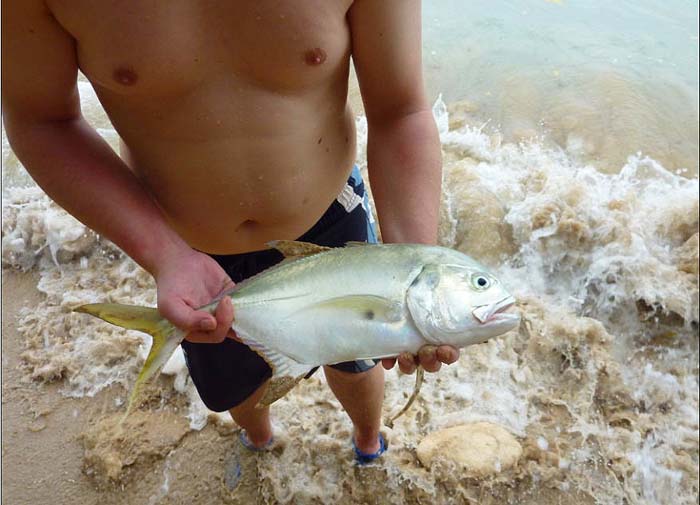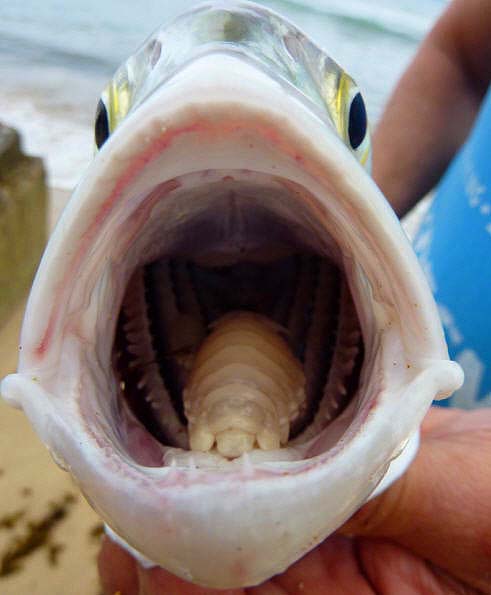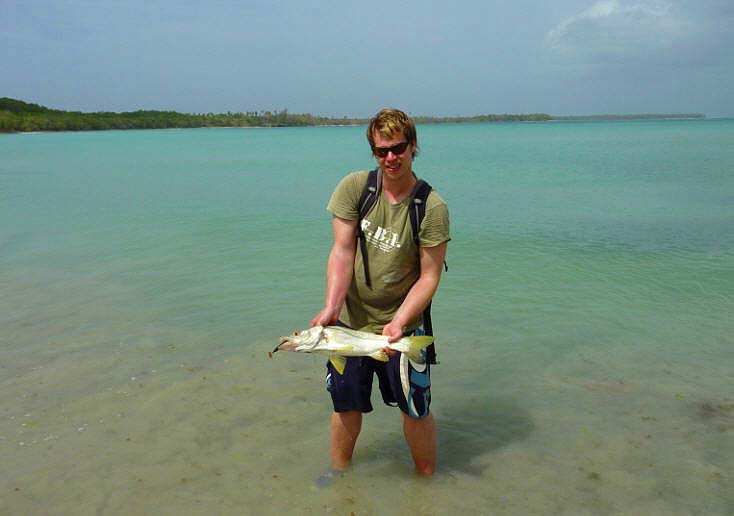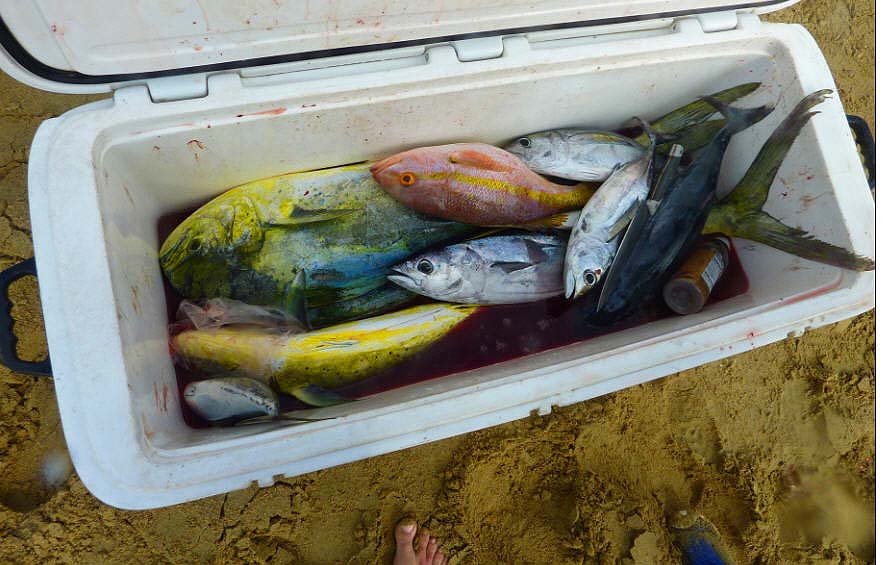

Catch Fish with
Mike Ladle
Information Page
SEA FISHING
For anyone unfamiliar with the site always check the FRESHWATER, SALTWATER and TACK-TICS pages. The Saltwater page now extends back as a record of over several years of (mostly) sea fishing and may be a useful guide as to when to fish. The Freshwater stuff is also up to date now. I keep adding to both. These pages are effectively my diary and the latest will usually be about fishing in the previous day or two. As you see I also add the odd piece from my friends and correspondents if I've not been doing much. The Tactics pages which are chiefly 'how I do it' plus a bit of science are also updated regularly and (I think) worth a read (the earlier ones are mostly tackle and 'how to do it' stuff).
Boris in Tobago.
Another of my epals, Boris, sent me an email about his recent trip to Tobago. Boris has fished over there before and his information fits in well with what I found on my last trip to the island. Here's his edited notes -
Hi Mike,
I've been back from Tobago for one week now. My fishing-pal and I had a holiday, but everything was a bit different than we expected.
Since telling you every detail about the entire week would fill books, I'll only write about a few of our experiences and try to give you the "big picture".
We arrived on Sunday 4th of April late in the afternoon and stayed until the following Sunday. We fished every dawn and every dusk except 2 mornings when we went out with a local Castara fisherman.
Except for one morning we blanked with sizeable jacks. However, on the Wednesday we had a few small horseeye and greenback jacks at Sandy Point near the "oil pipes". On this morning it was cloudy and we could see a few jack blitzes. The successful lures were surface types, like the Rapala Subwalk or Skitterpop. Interestingly, on my previous visit I saw lots of isopods inside the mouths of the jacks. This time they were there again. All the jacks that we caught had at least one of those creatures inside the mouth. The smaller jacks must suffer badly from these huge parasites! The isopod was filling nearly the entire mouth. Have you any idea how those "lice" affect the life of a fish Mike?
I've seen these big parasitic woodlice myself and they often cling to the tongues of the fish. On occasions, when more than one is present, they must almost block the entire mouth. I believe that scientific studies have shown that the growth of the fish is restricted by their presence.ML
We had 2 morning sessions after bonefish. On our first attempt I lost one and had a "follower" in quite high water (waist deep). The next morning we tried again and I caught one standard, Tobago-sized Bonefish in 2 hours fishing. My friend blanked. He did have a nice "take" on a popper in an area where there were moored boats. I think this was probably a decent sized jack.
We also caught some other stuff. One small snook and an even smaller follower in murky flats water at around 10 o'clock in the morning. There were also a few small Barracuda on the flat but they wouldn't take a lure and only followed a few times. Damn!
Thursday to Sunday morning we had extreme low tide at around 8:30 to 9:30. The fishing was hard. We tried our best with livebait from shore but without much success. I lost a bigger fish which took line from my 20 lbs boat rod and big multiplying reel but my line got snagged on a lone rock in waist-deep water. Except from 3 houndfish we caught nothing on any of these mornings.
We also fished quite a few evening sessions which produced one or two small jacks on small X-raps. Tarpon seemed to be absent. One evening at Sandy Point the snook were really on the feed. I started by losing a huge one. I estimated it to be around 1 to 1,1 m! It took the storm suspending shad only a few meters out from me and began jumping shortly after hookup. It leapt twice, totally clearing the water! As it jumped I could see that it had swallowed the entire rubber shad. Shortly after that I lost the bugger! I can't understand why but the snook had rubbed through my 0.40 mm Iron Claw hard mono. I mean - a snook has a mouth and "teeth" like a big perch. How the hell could it rough up my leader so badly?
I'm not sure believe it but I've read in American fishing mags that the gill covers of snook will cut the line.ML
On this evening there were lots of small fry (sprats?) close to the shore. From time to time we saw action among them. I switched to a 10cm X-rap and caught 3 snook, all between 50 and 60 cm and had a few more takes until sundown when the action ceased. I donít know why but my friend only had 1 lost Snook in the same time. He was using a similar but slightly different colour pattern. Maybe that was the reason... I was using AYU (Mullet) model. The following evening didn't produce a single snook at the same place.
I also have some general information about other locations. Plymouth Jetty was thick with fry. The water which surrounded the jetty was black with them. We tried one evening session there for snook and lost a decent tarpon on a Storm shad. From 6-9 pm we tried fishing with livebait but it produced nothing. Maybe we had the wrong baitfish. (We only had small grunts. We had one attempt for tarpon using sprats. This produced a few takes (short runs) and one hookup with a baby-baby tarpon which shook the hook out. At that time there were a lot of moored boats, so we didn't try too hard to catch a tarpon there. I bet that we would have lost anything we hooked on the the mooring ropes.
We fished various bays. One try in late morning produced nothing but houndfish takes. Another session produced one small jack on an Angel Kiss, 2 sand divers on an X-rap, 1 houndfish on a Subwalk and one squid (in darkness) on an Angel Kiss.
On our last day we first fished there for a while and then decided to say goodbye by snorkelling to the fish. I couldn't believe what my eyes saw... There was a decent barracuda lurking right in the area where we had fished some 5 minutes before. Grange Bay seemed absolutely blank. The jetties at sandy point showed nothing but big sprats. In Back bay we saw some jacks and small bonito while we were snorkeling but again we blanked. One try from Turtle Beach in darkness produced nothing.
In general there were lots of baitfish present, mostly fry up to 6cm. We only managed to catch bigger ones with our castnet from the jetties at Sandy point. The tarpon didn't show up in any great numbers. Sporadically we saw one rolling but this was nothing compared to my former visits. (Mainly in the rainy season). By livebait fishing from shore we'd really hoped to have had more tarpon. With our gear and our knowledge we would have caught at least a few during our past visits but this time they were very thin on the ground. The island was very dry and a lot of trees lost their leaves. Nearly everywhere you could see the brown "burnt" ground between the trees, palms and bushes.
It sounds like an extension of our last trip.ML
The week was over much too soon. I may that I will be able to go there again and hopefully in a "better time"! Our trips with the fisherman from Castara are also worth a mention. We went twice. On our first trip we wanted to catch mahimahi. The fisherman said: "We'll have to go far out!" with a glint in his eyes... This was the most exhausting fishing trip I have ever done in my life. We went out over 23 miles to reach the FADs. (After 16 miles there was no more Tobago on the horizon and no cell phone service). So this was a bit worrying with only one engine, no lifejackets and no oars.
That's normal - no doubt, in the event of a problem, the boatman would be able to swim back to shore!ML
On the first trip we caught four good sized mahimahi and a few Bonito and blackfin tuna. My friend got a bit seasick after a while, so we decided to fish the remaining sprats nearer the coastline. After 2.5 hours we reached the shore again, where we had a kingfish, red snapper, greenback/horseeye jacks and rainbow runners. I rigged a dead small bonito (the only small one which we caught outside) with the biggest hook and treble that I possessed. We trolled the fish only 20 m away from the rocks. I wasn't very convinced in this method because the bonito was "surfing" over the waves, but only 5 minutes after starting my Daiwa Saltist was screaming. A big barracuda had taken the bonito. Before I could tighten the drag of my reel the fish was into the rocks and my line was broken. What a pity!
Since the first trip was so exhausting (because of the big waves my butt was still hurting after 3 days) we decided, on our second voyage, to do "only" some inshore fishing with livebait. We caught the usual rainbow runner, red snapper, kingfish and a coney. We did see a shoal of jacks going after sprats near a big rock. I couldn't cast my multiplier with just the sprat so I tried my heavy spinning rod. The sprat landed in the blitz and I was immediately into a big jack. Even though I had 25 lb braided line I had no chance. The fish was heading into the rocks. After maybe 30 seconds without stopping, I could feel the line rubbing over the rocks and that was the end of a very nice fish. The Jacks were still in action. I was still angry about the fish which I lost but our fisherman took his handline and a sprat and cast skilfully into the blitz. At once he was into a jack. In contrast to mine, his fish went directly into deeper water. The result was an 8 kg Horseeye.
Thatís all Mike. A bit longer than I expectedÖ. Hope to read about you having a successful bass trip yourself soon!
Cheers,
Boris
Jack!

Parasite!

Snook!

Mixed bag!
